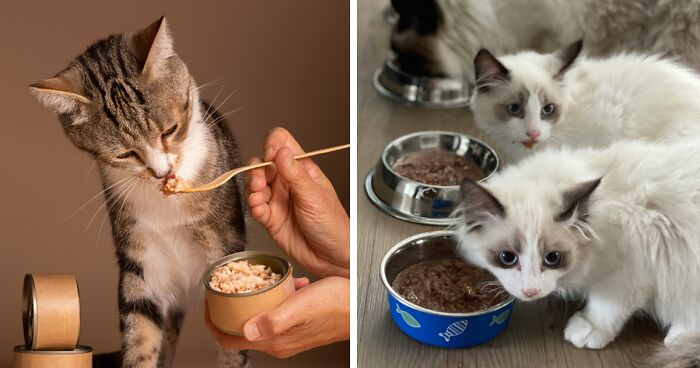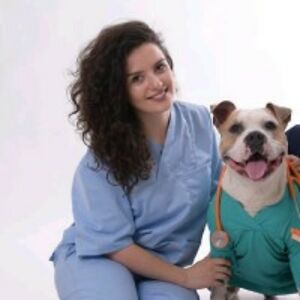Let’s admit it: you have probably been in a situation where you couldn’t resist your kitten’s cute eyes, and you decided to spoil it with some food.
Being a responsible cat parent does not mean you must do everything your cat is “making you do.” Sometimes, you need to be strict about certain things, including food.
Limiting the amount of food for your cat might be heartbreaking, especially if you notice that your kitten is looking for some more. For first-time cat owners, it might be tricky to determine how much to feed their kittens.
- Over the last decade, the number of overweight cats increased by 169% according to Banfield Pet Hospital.
- Obesity in cats is linked to about 20 diseases, including heart failure and diabetes.
- Wet cat food helps prevent dehydration and kidney issues, mimicking the moisture in a wild cat's diet.
- Cats' daily calorie needs vary by weight: a 5-pound cat needs 170 calories, and a 20-pound cat needs 440.
- Cats should have controlled food portions with two meals per day being the minimum recommended frequency.
The information provided herein is for informational purposes only. Please refer to our disclaimer for more details..
Why Is the Amount of Food Important for Cats?
According to a study by the Banfield Pet Hospital, over the past 10 years, the number of overweight cats has ballooned by 169%. Around 33% of cats in this study were fat. It might seem cute, funny, or adorable when you see a pet with extra weight, but it’s none of those things. In fact, obesity is linked to around 20 diseases that might lead to life-threatening consequences.
All cats have different nutritional needs, but don’t worry; most cats will try to trick you and eat as much as you feed them. That is why pet parents need to develop a strategic approach.
Cats indoors tend to burn fewer calories than roaming cats or cats kept outside. Let us warn you these cats might eat more due to boredom and lack of activities. So, if you have a cat in your home, try to provide it with more activities throughout the day.
Obesity can lead to an increased risk of many serious diseases, including heart failure, diabetes mellitus, skin infections, hepatic lipidosis, and even cancer. That is why it is crucial to maintain a balanced nutrition for your cat.
Why Choose Wet Food for Cats?
If you own both a dog and a cat, you might have noticed that your cat drinks less water than your dog. And why is that? Well, domestic cats get their water because most of them are used to wet cat food. On the other side, wild cats get water from fresh prey.
But what if you feed it with dry cat food? What happens then? Your cat has a high chance of under-consuming water, which might affect the kidneys. This can lead to overly concentrated urine and might require a veterinarian’s intervention.
According to studies, commercial dry food might lead to chronic kidney disease in cats.
Wet or canned food mimics the water found in prey and lowers the chances of kidney issues. These animals have more diluted urine and fewer health issues. If you feed your cat with wet food only, you will also reduce the chances of dehydration.
Cats must eat food rich in proteins and low in carbohydrates, so wet food is an ideal choice. For dry food to be prepared, it must contain carbohydrates, and carbohydrates are well-known to cause obesity in both humans and animals.
Factors That Determine the Amount of Food per Day for Cats
There are several factors that determine a cat’s nutritional needs, including:
- Age
- Weight
- Lifestyle
There are feeding guidelines on the food’s label, but there are also some general feeding rules for lean cats:
- A 5-pound cat – 170 calories per day
- A 10-pound cat – 280 calories per day
- A 15-pound cat – 360 calories per day
- A 20-pound cat – 440 calories per day.
Age feeding guideline
There are many feeding differences based on the animal’s age. Young kittens need especially balanced meals due to their rapid growth and high nutritional needs.
These cats need extremely high calcium requirements, especially during the first 6 months of age. Additionally, it is recommended for young cats to get supplements if needed. Adult and senior cats need less caloric food later in life as they become less active.
Weight feeding guideline
Usually, veterinarians determine the feeding guideline based on the cat’s weight and body condition. For example, lean and muscular cats are considered healthy and need more calories to maintain their overall health.
Conversely, cats with a petite frame are overweight and need fewer calories.
Reproductive status feeding guideline
Nursing cats need a special diet, which is a growth or lactation diet. Depending on the litter, the vet should determine and recommend a diet for this period. Cats are highly vulnerable during this period and tend to lose weight, so it is crucial to determine the best diet for them.
Activity feeding guideline
When vets decide about the cat’s diet and how much wet food they should take, they must consider the animal’s activity level. The body condition of the cat is also critical during this period.
Usually, cats that are kept indoors tend to be less active, so their daily food intake should be reduced if they don’t have enough activity throughout the day.
How Much Wet Food Is Enough for a Cat?
This is not a simple question, and there is no simple answer. Firstly, the cat needs to be evaluated by a veterinarian, and the diet will be determined by the cat’s age, weight, lifestyle, and reproduction status.
Some obese cats might even need special feeding instructions for weight loss. You can follow the abovementioned cat feeding guidelines, but it is best to consult a vet.
Also, be aware of the cat food portions and ensure the cat does not have 24/7 access to food. Two meals per day is the minimum, or they can eat multiple meals daily.
In case the vet suggests weight loss for your cat, you also need to be careful about the daily treats you offer. These treats might be harmless but contain a certain amount of calories.
Why Is the Amount of Food for Cats Important?
You should feed your cat balanced meals from a young age. This will lead to a healthy adult cat.
Obesity is the disease of the 21st century in both humans and animals. No wonder someone wise once said: You are what you eat. And we couldn’t agree more with this.
Cats with excess weight and decreased activity are at increased risk of many diseases. So, why gamble with your cat’s health when you can take small steps and have a completely healthy cat?
How to Choose the Best Canned Cat Food?
Choosing the best canned cat food is a nightmare for many pet parents. First of all, cats can be very picky regarding food. We are sure there is the best food for your cat somewhere on the market, but you must spend a lot of time trying.
You can start by reading the food label and the manufacturer’s recommendations. Then, read what type of meat it has. Let’s say you had some bad experience with chicken consumption, so that means that you should avoid canned chicken food.
If you struggle to choose your cat’s food, you should seek professional advice.
FAQ:
How much wet food should I feed my cat?
The amount of wet food depends on a few factors, including age, weight, reproductive status, and activity level. The veterinarian should decide how much food exactly is enough for your cat.
What are the disadvantages of wet cat food?
There aren’t many disadvantages of wet cat food. This food can be messy for the owner and might require a clean-up after the meal is finished. It also needs to be properly refrigerated, and this food cannot be stored on the shelf once it is opened. It should be consumed within 72 hours.
Is it OK to give cats wet food every day?
Yes, cats can and should eat wet food every day, mainly because this food is extremely well moisturized. Only ensure your cat gets the appropriate amount of food to maintain a healthy weight.
Is too much-wet food bad for cats?
No, wet food is the best choice for cats. This is the ideal food to feed your cat daily. Wet food contains enough proteins and fewer carbohydrates, which is the healthiest option for cats.
To Sum Up
Most adult cats eat up to two times per day, but it depends on a few factors. Every cat has different nutritional needs, so you must consult your vet on how much to feed a cat to maintain an ideal weight and healthy animal.
What type of food do you give your cat? We are curious; let us know in the comment section below!
14Kviews
Share on FacebookExplore more of these tags
Omg I feed 2 feral cats at work about four to five 5.5-oz of friskies in an 8 hour period span. Im new to this cat thing. I hated cats now I'm feeding them. I feel so bad for the sad life that they live that I tend to give them a little more, not knowing if their going to be alive the following day that I return to work.
I'm amazed at how much food my 4 month old kitten can pack away!I the adult cats eat 0ne 3 Oz can of food a day, and she eats 3 of those in a day! She's nowhere near overweight; she's a growing girl. I've always given my cats the best wet food I can afford, with a topping of a few crunchy morsels. Cats like the crunch and it's good for their teeth.
Omg I feed 2 feral cats at work about four to five 5.5-oz of friskies in an 8 hour period span. Im new to this cat thing. I hated cats now I'm feeding them. I feel so bad for the sad life that they live that I tend to give them a little more, not knowing if their going to be alive the following day that I return to work.
I'm amazed at how much food my 4 month old kitten can pack away!I the adult cats eat 0ne 3 Oz can of food a day, and she eats 3 of those in a day! She's nowhere near overweight; she's a growing girl. I've always given my cats the best wet food I can afford, with a topping of a few crunchy morsels. Cats like the crunch and it's good for their teeth.

 Dark Mode
Dark Mode 

 No fees, cancel anytime
No fees, cancel anytime 







 Image credits:
Image credits:  Image credits:
Image credits:  Image credits:
Image credits: 










































-3
7